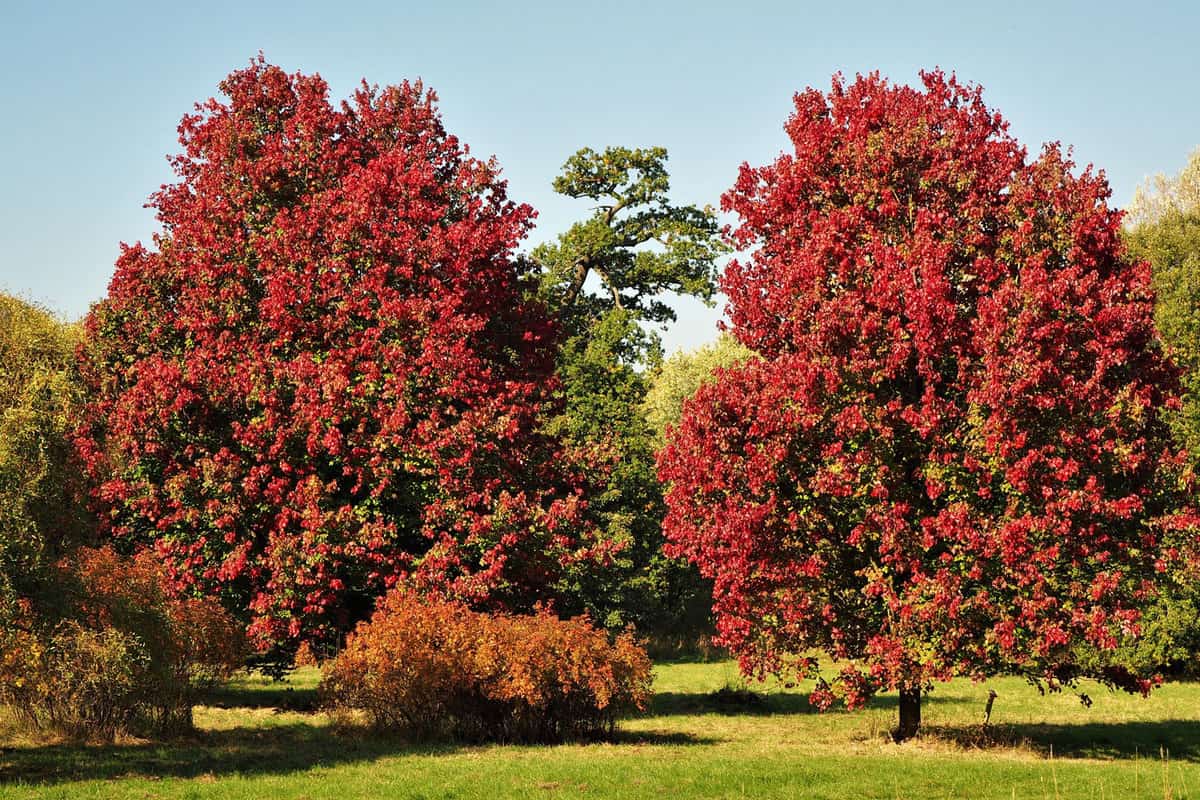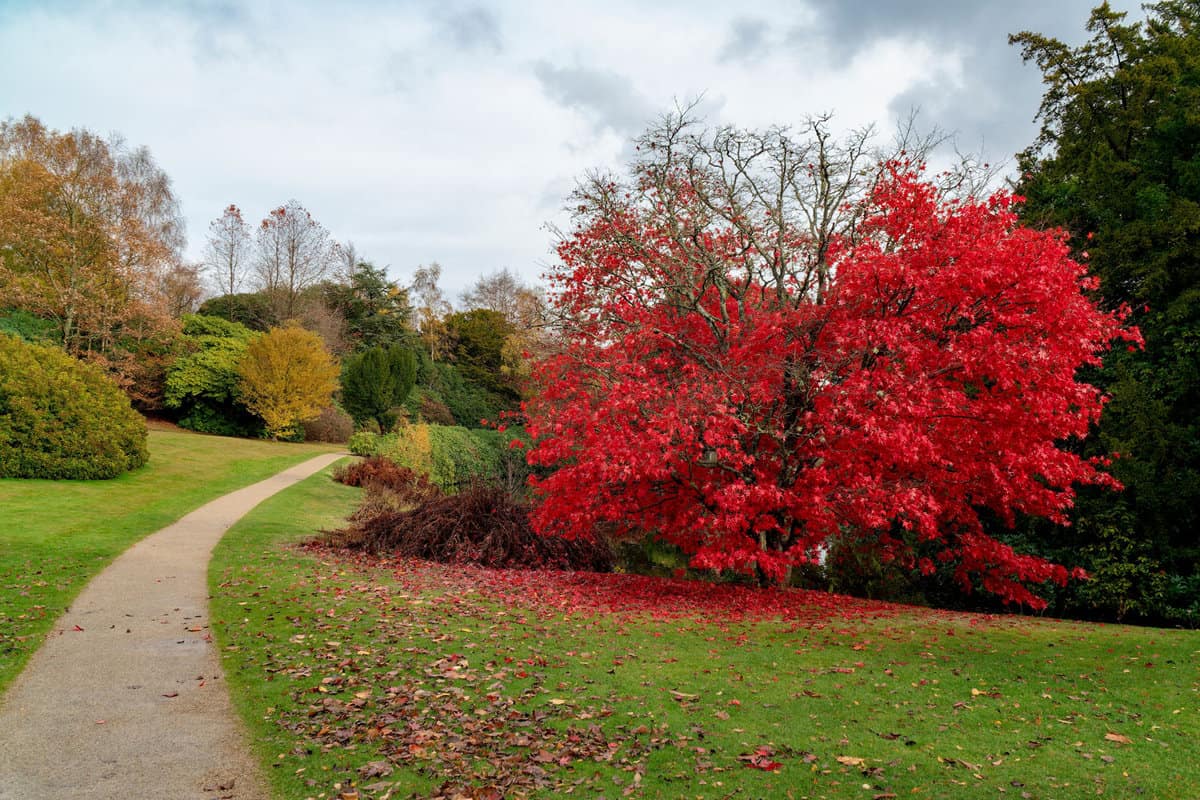Considering planting an October Glory Maple in your yard? This maple variety, a cultivar of Acer rubrum, is prized for its vivid autumn hues and adaptable growth traits.
Its roots are less invasive compared to many other maples, making it a favorite among homeowners.

Although its roots can spread, they usually don't cause severe damage to sidewalks or driveways when proper planting guidelines are followed.
Now, let's explore some tips for the right planting and upkeep of this beautiful tree.
Does October Glory Maple Have Invasive Roots?
October Glory Maple trees are known for their stunning fall colors and easy transplanting due to their shallow and wide root system. But do they have invasive roots?
In general, the root system of an October Glory Maple is not considered invasive.

These trees have a series of roots reaching outward from the trunk for stability and nourishment.
Because of its shallow but widespread root system, it's still essential to be mindful of where you plant your October Glory Maple.
When planted too close to structures like sidewalks, driveways, or homes, its sprawling roots can cause damage.
It's advisable to maintain a distance of at least 10 feet from sidewalks or roads and a greater distance of 20 to 25 feet from houses, patios, or other trees to prevent issues.
Also, make sure you're mindful of underground utilities and pipes to avoid any damage over time as the tree grows.
If you are still in the planning phase and looking for other maple varieties, you might find this article on the Best Maple Trees for Shade helpful.
October Glory Maple Root System Explained
The root system of the October Glory Maple tree is extensive.
You'll find anchoring roots that hold the tree firmly in place, while smaller feeder roots absorb moisture and nutrients. You may occasionally spot these feeder roots near the surface.
It does compete somewhat with plants within its canopy area – lawn grasses, perennials, shrubs, and so on would all have to compete with the tree for light, water, and nutrients.
Despite these, the October Glory Maple does not make a truly dense, almost impenetrable surface network of fine roots.
So, with proper planning and care, you can manage its root system effectively.
Does October Glory Maple Spread or Multiply?
Unlike some other species that spread rapidly through their root systems, the October Glory Maple maintains a more compact growth habit.
At a height of just 40-50 feet, this tree is more manageable in gardens and parks when compared to larger maples.
Although the tree itself may not multiply quickly, it does produce seeds that can be dispersed, leading to new trees sprouting in the surrounding area.
Nonetheless, this is a natural process that occurs with many tree species and cultivars, and it is not an alarming trait exclusive to the October Glory Maple.
How Do You Keep October Glory Maple From Spreading?
Firstly, choose the right location for your October Glory Maple. Plant it in an area with plenty of space to grow, away from infrastructure such as sidewalks, driveways, and pipes.
Regular maintenance is also essential in preventing the tree's roots from becoming invasive.
To control the tree's size and shape, perform minimal pruning at the end of summer or early fall.
Having the right tools can make this task easier and more efficient. Check out this BAYTORY Extendable Tree Pruner on Amazon.
After that, ensure that your October Glory Maple gets sufficient water during its establishment period, typically for one season.
Occasional watering is also a must during periods of drought. A well-watered tree is less likely to send out extensive roots in search of moisture.
Lastly, creating a defined tree circle can also help mitigate root-related issues.
Where is the Best Place to Plant an October Glory Maple?
Planting an October Glory maple tree in the right location is essential to ensure its healthy growth and beautiful display of color.
You should plant your October Glory maple in an area with full sun for the best autumn colors.
Any type of soil can work as long as it has good drainage. Sandy soil might require some more watering, though.
Consider the size of the tree at maturity when choosing a planting spot. An October Glory maple can reach a height of 40 to 50 feet and thrive in zones 5 through 9.
Again, with its shallow roots, it is essential to avoid planting near sidewalks or driveways.
These roots may disrupt the hardscape, but they are generally less invasive than most maples.
Can You Plant an October Glory Maple Close to a House?
As a general rule of thumb, it's recommended to plant trees no less than half the mature canopy spread away from a structure.
For the October Glory maple, this means you should plant it at a minimum of 20 feet away from your house.
Giving the tree more space will ensure it can grow properly, and your home foundation will remain undisturbed.
Keep in mind that while the roots may not be as invasive, they can still spread a bit further than the tree canopy.
You might occasionally encounter some difficulties with mowing your lawn around the tree, but creating a defined tree circle can help in mitigating this issue.
Can October Glory Maple Roots Damage Foundation or Pipes?
While the roots themselves might not be invasive, planting any tree too close to your foundation or pipes can lead to potential problems, such as soil displacement or root encroachment.
Ideally, plant your October Glory Maple in a spacious area to give its roots plenty of room to grow without causing any damage.
How Much Space Does October Glory Maple Need?
When planting an October Glory Maple, it's important to give the tree enough space to grow.
One crucial factor to consider is the distance from other trees or structures. Leave enough room for the tree's canopy to expand without interference.
As mentioned, a safe distance would be at least 20 to 25 feet away from other trees, buildings, or power lines.
When it comes to root spread, the October Glory Maple is not known for having invasive roots.
However, it's still a good idea to provide ample space for root growth to prevent potential issues.
If you are experiencing issues with leafing, you may want to read about Why Some maple Trees May Not Leaf Out and how to address them.
Final Thoughts
When it comes to the October Glory Maple, it's important to consider the root system of this beautiful tree.
Although it is not typically considered invasive, the root system is known to be shallow and wide.
So, before deciding to plant an October Glory Maple, be sure to take into account your specific location and circumstances.
Always keep in mind the aesthetic and practical implications of adding a tree with this type of root system to your landscape.
Careful planning and consideration go a long way in making your garden a harmonious and pleasant environment within your outdoor space.

